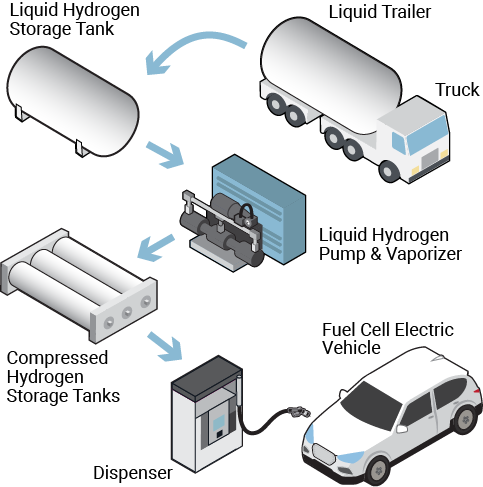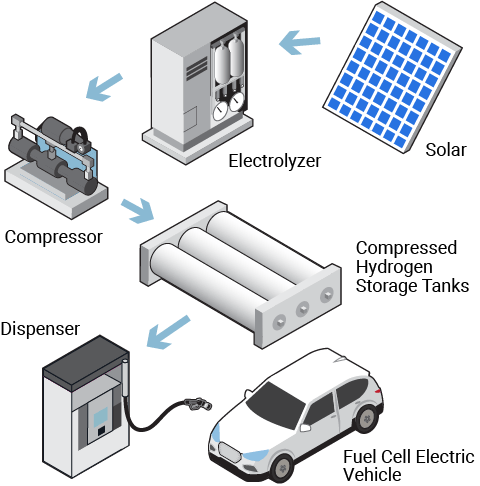The cost of building a hydrogen fueling station depends on several factors, including the size and location of your station. The average cost is around $2 million for a gas station-size hydrogen facility.
Location plays an important role in the cost of building a hydrogen fueling station. The most expensive cities are New York City, Los Angeles and San Francisco, with average costs ranging from $2-$3 million per station. Other expensive locations include London, Tokyo and Sydney. The least expensive cities are Dubai, Riyadh and Kuwait City, where hydrogen stations cost less than $1 million each.
The size and design of your hydrogen station will also affect its cost. Smaller stations can be built for as little as $100,000 but may only have one dispenser that dispenses up to 1 kilogram (kg) per minute (gpm). Larger stations can cost several million dollars because they need multiple dispensers that dispense up to 5 kg/min each

How much does it cost to build a hydrogen fueling station
Hydrogen station cost calculator, building hydrogen fueling stations, capital cost of hydrogen electrolysis plant, how much does it cost to build a hydrogen plant.
Hydrogen station cost calculator
The cost of a hydrogen fueling station depends on the type of technology used. The most common are:
Conventional compressed hydrogen stations
These facilities use pressurized tanks to store hydrogen at high pressure and temperature, which means they require more maintenance than other types of fueling stations. They also need more space for storage tanks and equipment. These factors can make them expensive to build and operate.
Electrolyzers
A hydrogen electrolyzer uses electricity from the grid or renewable sources like solar panels or wind turbines to split water into hydrogen and oxygen through an electrochemical process called electrolysis. The resulting hydrogen is stored in high-pressure tanks until it’s needed by customers whose vehicles can use it as a fuel source.
Hydrogen is a clean fuel for vehicles and other applications. Hydrogen stations are required to refuel hydrogen-powered vehicles.
Build your own hydrogen station with our free hydrogen station cost calculator.
The following is a list of the estimated capital costs for building a hydrogen fueling station:
Cost of equipment (pump, compressor, etc.) – $5,000 – $25,000
Electrical metering and wiring – $20,000 – $50,000
Site preparation and installation of equipment – $5,000 – $25,000
Total capital cost – $30,000 – $100,000
Hydrogen is a clean fuel which can be used in cars and trucks. Hydrogen is the most abundant element in the universe, but it does not occur naturally on Earth. It can only be produced from other elements like natural gas, methane or water.
Hydrogen has been touted as the fuel of the future because it produces no carbon emissions when it burns. Hydrogen-powered vehicles are already on the road in California, Japan and Germany, however these vehicles have limited range and cost more than conventional cars powered by gasoline or diesel.
The cost of building a hydrogen station depends on several factors including location and whether you are using renewable energy sources to make the hydrogen fuel. The following guide provides some basic information about how much it costs to build a hydrogen fueling station:
The cost of building a hydrogen station depends on a number of factors. A single station can cost anywhere from $1 million to $5 million or more, depending on its size and complexity. The cost of building a hydrogen station includes labor, materials and equipment as well as site preparation costs.
The main component in the cost of building a hydrogen station is the hydrogen generation system. Hydrogen stations typically use electrolysis to produce the gas from water. The electrolysis process requires electricity, which is generated by burning natural gas or some other fuel source at the station. The cost of electricity is one factor that affects the overall price tag of building a hydrogen station.
In addition to electricity costs, there are other factors that affect how much it costs to build a hydrogen fueling station including:
Labor – Labor expenses vary depending on who builds your hydrogen station and how many people work on it at once. If you’re hiring local contractors, expect to pay more than if you have your own team on-site working around-the-clock for days or weeks at a time. If you hire contractors from out-of-state, their travel expenses may also add to labor costs for your project.
Materials – Materials used in constructing your hydrogen fueling station will also affect its
Hydrogen gas is the most abundant element in the universe, but it’s very hard to make. It’s so difficult to extract that the hydrogen you buy at the pump today comes from fossil fuels.
Hydrogen is a clean-burning fuel that can be used in a variety of ways: cars, trucks, buses and trains run on it. It also can be used to power homes and businesses, or even store energy from solar panels or wind turbines.
In this article, we’ll look at how much it costs to build a hydrogen fueling station. But first, let’s take a closer look at what goes into creating hydrogen gas.

Is hydrogen fuel expensive to produce
Hydrogen is a clean, efficient, and renewable energy source. It is an alternative fuel that can be used in a hydrogen fuel cell to run vehicles or power homes. The cost of producing hydrogen varies depending on the method used, but it costs more than $2 per kilogram to produce using electrolysis.
The cost of producing hydrogen using electrolysis depends on several factors:
The size of the plant. Smaller plants tend to be cheaper than larger plants because they have lower capital costs per unit of output. However, if you want to produce large amounts of hydrogen at once, you’ll need a large plant with high operating costs per unit of output.
The type of electrolyzer you use. Different types of electrolyzers have different operating costs and efficiencies, so you should choose the most efficient model for your needs based on your budget and desired output rate. For example, if you want to produce 10 kilograms per hour (kg/h), then a membrane-type electrolyzer would be more suitable than a solid polymer electrolyzer because it has higher efficiency at low flow rates and lower capital costs per kilogram produced.
It’s not cheap to build hydrogen stations. The National Renewable Energy Laboratory estimates that it costs around $2.50 per kilogram to produce hydrogen from electrolysis, and about $4/kg for steam reforming of natural gas. (The rest of the cost is in transportation.)
NREL also estimates that it costs about $3 million per station, including land and site preparation, construction, automation and safety systems, fueling equipment and dispensers, electrical service upgrades and emergency back-up power supplies. That’s for a station with a capacity of about 1 MW (1 million kg/hr), with four dispensers capable of serving 10 cars per minute each (about 40 cars per hour). The average refueling time is 8 minutes.
If you want to build an entire network of hydrogen stations — rather than just one or two — you’ll need more than just one or two stations. And that means more money spent on each station along the way.”
Hydrogen fuel is not expensive to produce, but there are several factors that affect its cost. The first is the cost of producing hydrogen using electrolysis. This involves using electricity to split water into its constituents, hydrogen and oxygen gas.
Hydrogen can be produced using fossil fuels or renewable energy sources such as wind and solar power. For example, a wind turbine or solar panel generates electricity, which is then used to split water into hydrogen and oxygen gas by passing an electric current through it.
The capital cost of building a hydrogen station is also a factor that affects hydrogen fuel prices. The more stations that are built, the cheaper it will get for businesses to transport their goods with hydrogen-powered trucks and vehicles. As more people use hydrogen fuel on a regular basis and more businesses invest in expanding their fleets of vehicles powered by this alternative energy source, demand for these vehicles will increase as well.
This increases competition between companies for manufacturing parts for these vehicles and building fueling stations where they can fill up their tanks with clean energy instead of diesel or petrol. This drives down the price of building these facilities until eventually it becomes affordable for every business owner who wants to cut down on carbon emissions while saving money on fuel costs at the same time
The cost of building a hydrogen station is about $4 million to $5 million, according to a hydrogen station builder.
The cost of building a hydrogen station depends on the size of your station and how many vehicles are expected to use it. The average cost is around $4 million to $5 million dollars for a small station that can serve about 10 cars per day. A larger station that can serve 100 cars per day would cost about $20 million to build.
The cost of building a hydrogen station also depends on where you are located, as well as other factors like:
– The number of people who live in your area and how many vehicles they drive;
– Whether there are other stations nearby;
– How much money you have available for construction;
The cost of producing hydrogen is the biggest obstacle to its use. While there are many theoretical ways to produce hydrogen, none are commercially viable. The most common methods used today are electrolysis and steam reformation.
Hydrogen is currently produced from natural gas or coal by steam reforming and from hydrocarbons by partial oxidation. A third method, which is being considered as a means of reducing greenhouse gases, is the use of solar energy to split water into hydrogen and oxygen.
The amount of energy required to produce hydrogen varies depending on the method used. For example, electrolysis requires 5 to 6 kilowatt-hours (kWh) per kilogram (kg), while partial oxidation requires 7 kWh/kg and steam reforming requires 10 kWh/kg.
